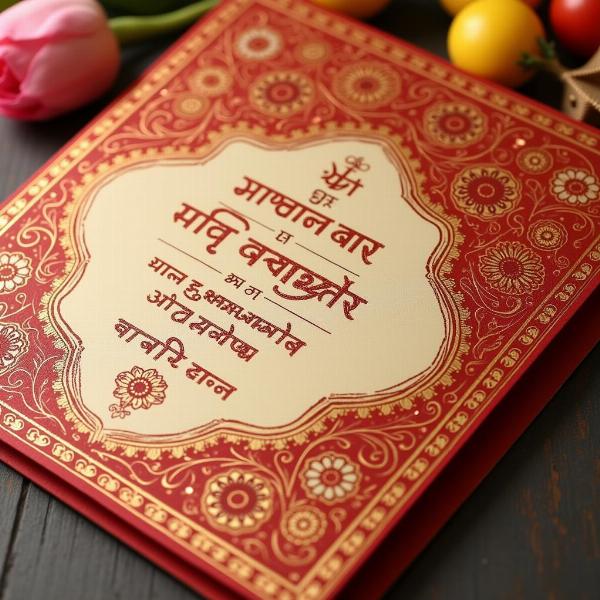Understanding the nuances of invitation in Hindi is crucial for navigating social and professional situations in India. Whether it’s a formal business meeting or a casual get-together, choosing the right words to convey your invitation can significantly impact how it’s received. This article explores the meaning of “inviting” in Hindi, delving into various contexts, synonyms, and cultural implications. We’ll equip you with the vocabulary and cultural understanding to extend invitations gracefully and appropriately in any situation.
Different Ways to Say “Invite” in Hindi
The most common Hindi word for “invite” is आमंत्रित करना (aamantraN karna). This verb is versatile and suitable for most formal and informal settings. However, depending on the context and level of formality, several other words and phrases can convey the meaning of “inviting” more effectively.
- निमंत्रण देना (nimantraN dena): This is a more formal way of saying “to invite,” often used for weddings, religious ceremonies, and official events.
- बुलाना (bulaana): This word implies “to call” or “to summon,” and is generally used in informal settings among friends and family.
- आमंत्रण भेजना (aamantraN bhejna): This phrase literally means “to send an invitation,” and is appropriate for formal events where written invitations are customary.
- निवेदन करना (nivedan karna): This is a more humble and respectful way of inviting someone, often used when inviting elders or respected figures.
Cultural Context of Invitations in India
Indian culture places significant emphasis on hospitality and welcoming guests. Invitations are often extended with warmth and enthusiasm, and refusing an invitation without a valid reason can be considered impolite. It’s common to insist multiple times, and guests are expected to reciprocate the invitation at some point.
Formal vs. Informal Invitations
The language used for invitations varies significantly based on the formality of the occasion. Formal invitations often use respectful language, whereas informal invitations can be more casual and direct. For example, inviting a business associate would require a more formal tone than inviting a close friend.
Formal Invitations: Examples
- “आपको हमारे कार्यालय के उद्घाटन समारोह में आमंत्रित करते हुए हमें अत्यंत प्रसन्नता हो रही है |” (Aapko hamaare kaaryaalay ke udghaatan samaaroh mein aamantraN karte hue hamein atyant prasannata ho rahee hai.) – We are delighted to invite you to the inauguration ceremony of our office.
- “हमें आपके शुभ आगमन की प्रतीक्षा रहेगी।” (Hamein aapke shubh aagaman kee prateeksha rahegee) – We eagerly await your gracious presence.
Informal Invitations: Examples
- “कल घर आ जाना, खाना साथ खाएंगे।” (Kal ghar aa jaana, khana saath khaenge.) – Come over tomorrow, we’ll have dinner together.
- “पार्टी में जरूर आना यार!” (Party mein zaroor aana yaar!) – Do come to the party, friend!
Responding to Invitations in Hindi
Knowing how to respond to invitations is equally important. Accepting an invitation can be expressed with phrases like “ज़रूर आऊँगा/आऊँगी” (zaroor aaunga/aaungi) meaning “I will definitely come.” Declining an invitation politely can be done by expressing regret and offering a valid reason.
How do you say “Are you invited?” in Hindi?
Asking “Are you invited?” in Hindi depends on the context and level of formality. Informally, you could ask “क्या तुम्हें बुलाया है?” (Kya tumhein bulaya hai?). A more formal way would be “क्या आपको आमंत्रित किया गया है?” (Kya aapko aamantraN kiya gaya hai?).
The Importance of Choosing the Right Words
Using the appropriate vocabulary and tone when inviting someone in Hindi reflects respect and understanding of Indian culture. It sets the right tone for the interaction and fosters positive relationships.
Conclusion
Mastering the art of inviting in Hindi involves understanding not just the vocabulary but also the cultural nuances that surround it. Whether it’s a formal event or a casual gathering, using the correct words and phrases can make all the difference. By understanding the various synonyms, formal and informal variations, and cultural expectations, you can confidently navigate social and professional situations in India.
FAQ
- What is the most common way to say “invite” in Hindi? आमंत्रित करना (aamantraN karna)
- How do you invite someone formally to a wedding in Hindi? निमंत्रण देना (nimantraN dena) is a more formal term suitable for weddings.
- Is it considered rude to decline an invitation in India? Yes, declining without a valid reason can be considered impolite.
- How do I say “I will definitely come” in Hindi? ज़रूर आऊँगा/आऊँगी (zaroor aaunga/aaungi)
- What is a polite way to decline an invitation in Hindi? Express regret and offer a genuine reason for declining.
 Hindi Invitation Card
Hindi Invitation Card
Meaning-Hindi.in is your one-stop solution for all your Hindi translation needs. We offer a range of services from business and legal document translation to website localization and specialized technical translation. Our team of expert linguists ensures accurate and culturally sensitive translations, bridging the language gap effectively. For any inquiries, contact us at [email protected] or call us at +91 11-4502-7584. Let Meaning-Hindi.in help you connect with the world through the power of language.